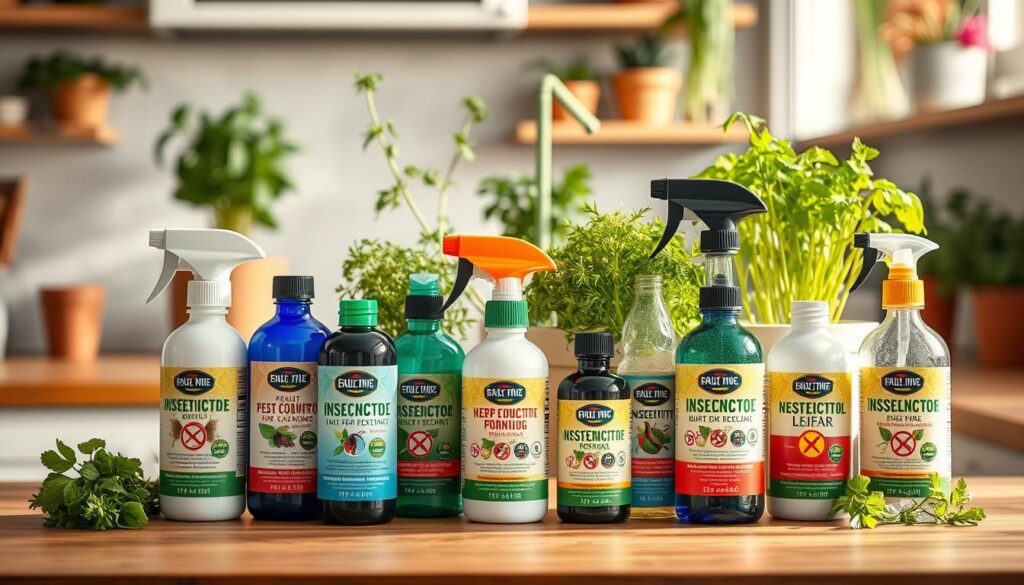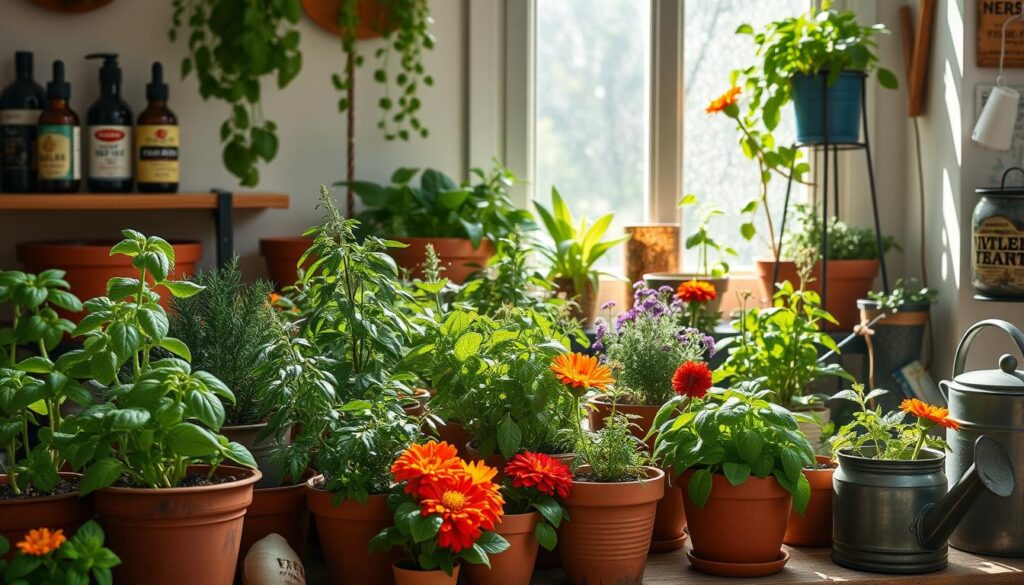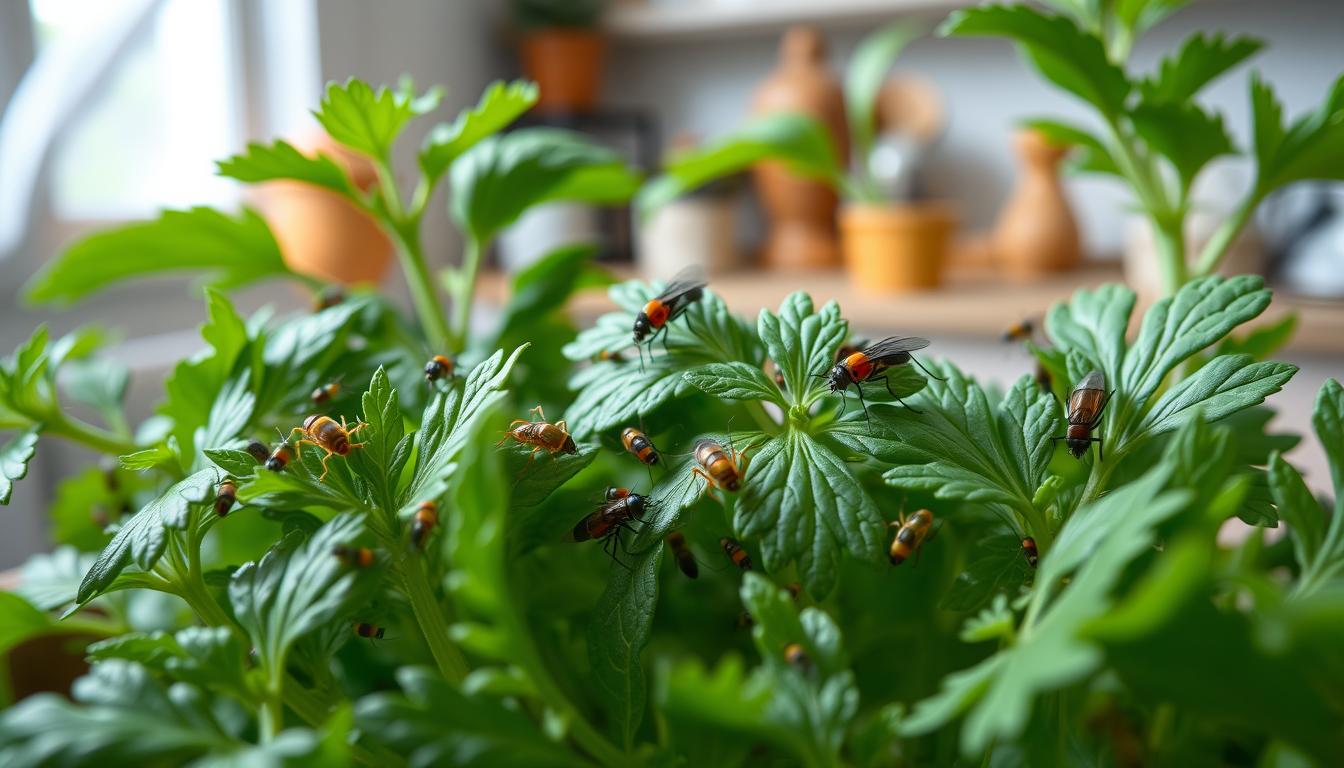Did you know a single aphid can have up to 12 babies a day? This fact shows how crucial it is to watch over your indoor herb garden for pests. To keep your herbs healthy, you need to stay alert and use the right pest control methods. This guide will show you how to use natural and organic ways to keep pests away and grow a healthy garden.
Key Takeaways
- Learn about the pests that bother indoor herb gardens and why managing them is key.
- Find out about natural and organic ways to fight pests, like homemade sprays and helpful insects.
- See how to make your own insecticidal soap spray to tackle indoor herb pests.
- Discover commercial insecticides for big pest problems in your indoor herb garden.
- Learn about integrated pest management to fight pests in a complete way.
Introduction to Indoor Herb Garden Pests
Growing an indoor herb garden is rewarding, giving you fresh herbs for cooking. But, pests can harm your plants. Knowing about common pests and how to manage them is key to a successful garden.
Common Pests in Indoor Herb Gardens
Many pests can harm indoor herb gardens, including:
- Aphids: These small insects suck plant sap, causing leaves to turn yellow and grow poorly.
- Whiteflies: These tiny insects also suck sap, making plants weak and spreading diseases.
- Spider mites: These tiny arachnids build webs and harm your herbs by sucking their sap.
- Thrips: These insects eat leaves and flowers, making them look distorted and discolored.
- Slugs: These pests eat herb leaves and stems at night, leaving slime trails.
Importance of Pest Management for Healthy Herbs
Managing pests is vital for a healthy indoor herb garden. Without it, pests can overwhelm your plants, reducing growth and spreading diseases. A good pest control plan helps protect your herbs, keeps your kitchen fresh, and avoids harsh chemicals. It’s key to a thriving garden.
Knowing about pests and how to manage them helps protect your plants. This way, you can enjoy a harvest of fresh, healthy herbs.
Natural and Organic Pest Control Methods
When growing herbs for eating, it’s key to avoid harsh chemicals. Luckily, there are great natural and organic pest control methods to use. These include simple homemade sprays and planting certain herbs together. These methods help control pests without harming your herbs.
Garlic Spray for Aphids, Whiteflies, and Spider Mites
A garlic spray is a top choice for fighting pests. Garlic naturally keeps away aphids, whiteflies, and spider mites. To make your own garlic spray for indoor herb pests, mix garlic with water, strain it, and spray on the plants.
Essential Oil Sprays for Pest Repellent
Essential oil sprays are another great way to control pests. Oils like peppermint, lavender, and neem oil make a bad place for pests. Mix a few drops of these oils with water in a spray bottle. Then, spray your plants often to keep pests away.
“Maintaining a healthy, pest-free indoor herb garden doesn’t have to mean relying on harsh chemicals. With a few natural and organic techniques, you can keep your herbs thriving without compromising the quality or safety of your homegrown produce.
DIY Insecticidal Soap Spray
Keeping your indoor herb garden pest-free doesn’t need harsh chemicals. A homemade insecticidal soap spray can control pests like aphids, spider mites, and whiteflies. Mix mild liquid soap with water to make a safe solution to keep these pests away from your herbs.
Making your own insecticidal soap spray is easy and saves money. This natural method targets pests that harm your herbs without using harsh chemicals.
Ingredients for DIY Insecticidal Soap Spray
- 1 tablespoon of mild liquid soap (such as castile or vegetable-based soap)
- 1 quart (4 cups) of water
- A clean spray bottle
Instructions for Making Insecticidal Soap Spray
- In the spray bottle, mix the liquid soap and water well.
- Spray the solution on your indoor herb plants, focusing on the undersides of leaves where pests hide.
- Reapply every 7-10 days or as needed to keep pests under control.
This homemade insecticidal soap spray is safe and effective for your indoor herb gardens. It keeps pests away without harming your herbs or your indoor air quality. This simple solution protects your herbs and keeps your family safe from harsh chemicals.
| Ingredient | Quantity | Purpose |
|---|---|---|
| Mild liquid soap | 1 tablespoon | Acts as the insecticidal agent, disrupting the pests’ cell membranes |
| Water | 1 quart (4 cups) | Dilutes the soap to create the spray solution |
| Clean spray bottle | 1 | Applies the solution evenly to the affected plants |
“A natural, non-toxic approach to pest control is essential for maintaining a thriving indoor herb garden.”
With this easy DIY recipe, you can make a DIY insecticidal soap spray for indoor herb gardens. It effectively controls pests without harming your herbs or your indoor space.
Herb garden pests indoor solutions
For indoor herb gardens, natural and organic methods are often the best choice. But sometimes, you might need a stronger solution for pests. Look for commercial insecticides that are safe for edible plants and have natural ingredients. Check with your local gardening center or research well to find the right product for your pests.
Commercial Insecticide Options for Indoor Herbs
When fighting off indoor herb garden pests, there are many commercial insecticides to consider. These products use natural ingredients, making them safer for your herbs. Some top choices include:
- Neem oil-based insecticides, which work well against aphids, whiteflies, and spider mites.
- Insecticidal soaps, made from potassium salts of fatty acids, for controlling soft-bodied insects.
- Pyrethrins, a natural insecticide from chrysanthemum flowers, effective against chewing and sucking pests.
Always follow the product instructions when using commercial insecticides. Pay attention to dosage, how to apply it, and safety tips. Test it on a small area first to make sure it won’t harm your herbs.
“Integrating a variety of pest control methods, both natural and commercial, is often the most effective way to maintain a healthy and thriving indoor herb garden.”

Commercial insecticides can be helpful, but use them wisely and only when needed. Always try natural and organic methods first to keep your indoor herb garden safe and sustainable.
Monitoring and Applying Pest Control Treatments
Keeping pests away from your indoor herb garden means watching closely and acting fast. Check your plants often for pests. Use sticky cards and your eyes to see how many pests you have. Then, use pest control methods like natural sprays or insecticides as directed.
It’s key to watch your indoor herb garden closely to spot pests early. Look for signs like
- Discolored or wilted leaves
- Visible insects or their eggs
- Webbing or sticky residue on the plants
Sticky traps or yellow cards can catch flying pests like aphids and whiteflies. Check under leaves and the soil for crawling pests.
After finding pests, it’s time to treat them. Natural and organic pest control methods, like garlic sprays, work well against many pests. For big infestations, you might need commercial insecticides made for edible plants.
“Consistency is key when it comes to monitoring and applying pest control treatments in your indoor herb garden. Regular vigilance and a proactive approach can help you maintain a healthy, thriving herb garden.”
Always follow the product instructions when using pest control products. Think about how they might affect your herbs and the environment. With careful monitoring and treatment, you can keep pests out and enjoy a great harvest.
Trapping Techniques for Indoor Herb Pests
Using natural sprays and organic treatments is great, but trapping techniques can also help manage pests in your indoor herb garden. These methods can get rid of many pests, like crawling insects and slugs, without using harmful chemicals. This lets your herbs grow well.
Cornmeal and Sticky Traps for Crawling Insects
Cornmeal traps are a smart way to catch pests like ants, beetles, and earwigs. Just put a thin layer of cornmeal near your plants. The pests will be drawn to it but can’t eat it, so they’ll die. For flying pests like whiteflies and gnats, sticky traps work well. They catch these pests before they can harm your herbs.
Beer Traps for Slugs
Slugs can be a big problem in indoor gardens, but beer traps can help. Put some beer in a shallow container and place it near your herbs. The slugs will come for the beer and won’t leave. This is a safe way to keep your herbs safe from pests.
Adding these trapping methods to your pest control plan can help fight off many pests. This way, your plants will stay healthy and pest-free. Always check your garden often and change your traps as needed to keep pests away.
“Trapping pests is a smart, sustainable way to safeguard your indoor herbs without relying on harsh chemicals.”
Beneficial Insects for Biological Control
Use nature’s pest controllers in your indoor herb garden! Introducing beneficial insects is a green way to fight pests. Ladybugs, mealybugs, and praying mantis can hunt and control pests naturally, without harsh chemicals.
Introducing Ladybugs, Mealybugs, and Praying Mantis
Ladybugs eat up to 50 aphids daily. Adding these beetles to your garden fights aphid infestations and protects your herbs. Mealybugs eat spider mites, a common indoor pest. These bugs help keep your herbs free from webs and discoloration.
For a big pest control solution, try praying mantis in your garden. These insects eat many pests, like aphids, mealybugs, caterpillars, and flies. Their hunting skills quickly balance out your garden, helping your herbs grow well.
| Beneficial Insect | Target Pests | Benefits |
|---|---|---|
| Ladybugs | Aphids | Voracious eaters, can consume up to 50 aphids per day |
| Mealybugs | Spider Mites | Effective predators of spider mites, help prevent webbing and discoloration |
| Praying Mantis | Wide range of pests (aphids, mealybugs, small caterpillars, flies) | Impressive hunting skills, quickly restore balance in the indoor herb garden |
By using these beneficial insects for biological control, your indoor herb garden gets a natural pest management. This way, your herbs stay healthy and grow well.
Cultural Practices for Pest Prevention
Keeping your indoor herb garden healthy and pest-free is more than just fighting pests. Using good cultural practices helps prevent infestations. Pruning and companion planting are two important strategies to consider.
Pruning for Pest Deterrence
Pruning your indoor herb plants is key to their health. Cutting away dead or damaged leaves improves air flow and stops pests from settling. It also makes your plants grow fuller and stronger, making it tough for pests to get a foothold.
Always use clean, sharp tools and disinfect them between plants. This prevents diseases and pests from spreading.
Companion Planting for Pest Deterrence
Companion planting is a long-standing gardening technique. By placing certain herbs and plants near your indoor garden, you can keep pests away naturally. Some good companions include:
- Marigolds: Their strong scent keeps aphids, spider mites, and other pests away.
- Lavender: Lavender’s oils repel moths, fleas, and beetles.
- Basil: Basil’s strong smell confuses and deters many pests.
Using these cultural practices for pest prevention in indoor herb gardens helps your garden thrive. With pruning and companion planting for pest deterrence, your indoor herbs will be pest-free and healthy all year.

Integrated Pest Management Approach
To keep your indoor herb garden pest-free, use an integrated pest management (IPM) approach. This method combines natural sprays, traps, beneficial insects, and cultural controls. Together, they create a strong system to manage pests and keep your herbs healthy and productive.
Combining Multiple Strategies for Effective Control
Using different strategies is key to controlling pests in your indoor herb garden. Start with natural and organic methods like garlic sprays and essential oil repellents. These can help fight off aphids, whiteflies, and spider mites.
Add DIY insecticidal soap sprays and traps like cornmeal and sticky traps for crawling insects. Beer traps can catch slugs. This mix of methods helps control pests effectively.
Bring in beneficial insects like ladybugs, mealybugs, and praying mantis to your garden. These insects eat pests, keeping your garden balanced. Also, prune and plant herbs together to keep pests away and improve your herbs’ health.
FAQ
What are the common pests that can infest indoor herb gardens?
Why is proper pest management crucial for maintaining a healthy indoor herb garden?
What are some effective natural and organic pest control methods for indoor herbs?
When is it necessary to use commercial insecticides for indoor herb gardens?
How can you effectively monitor and apply pest control treatments in your indoor herb garden?
What trapping techniques can be used to manage pests in an indoor herb garden?
How can beneficial insects help control pests in an indoor herb garden?
What cultural practices can help prevent pest infestations in an indoor herb garden?
What is an integrated pest management (IPM) approach, and how can it benefit your indoor herb garden?
Source Links
- 4 Ways to Kill Bugs in Herb Gardens – wikiHow – https://www.wikihow.com/Kill-Bugs-in-Herb-Gardens
- Need to kill insects on herbs indoors – https://www.houzz.com/discussions/1931474/need-to-kill-insects-on-herbs-indoors
- Pest Management for Herb Bedding Plants Grown in the Greenhouse | Integrated Pest Management – https://ipm.cahnr.uconn.edu/herbs-greenhouse/





